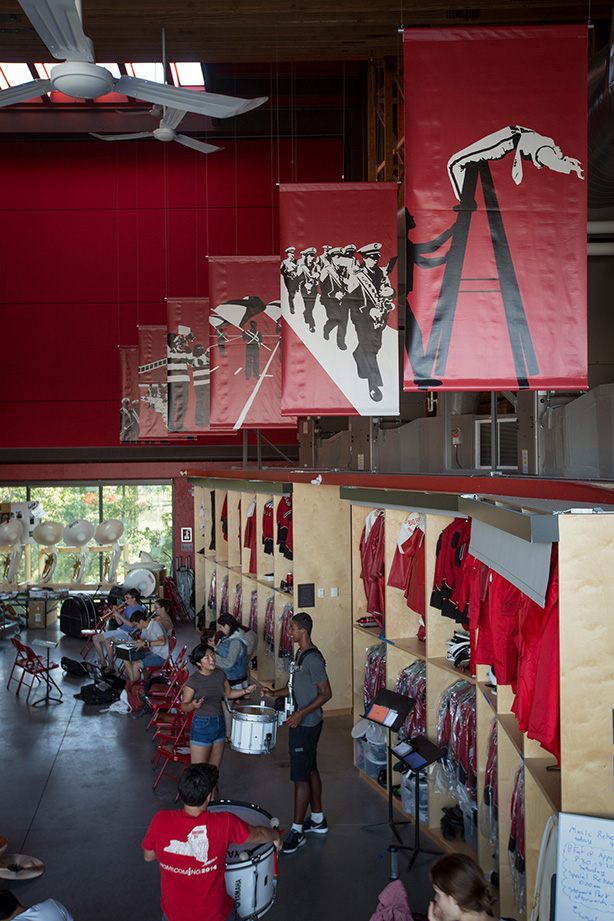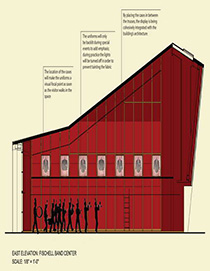Around Campus
Translating the passion: Finishing touches by design class make new Fischell Band Center home for the Big Red Bands

An exhibit design class in the College of Human Ecology taught by senior lecturer Rhonda Gilmore created interior "design interventions" to translate the Big Red Bands' passion into visual details in its new home.
For decades, the Big Red Bands, a Cornell musical fixture for more than a century, called a small room in Barton Hall home. Full of band memorabilia, from old drum major uniforms to award plaques to messages scribbled on the walls from past members, the old room was highly personalized – but cramped.
"Over time, the band completely outgrew the space," says Sarah Fischell '78, a former Big Red percussion player and passionate supporter. The need for a new space inspired her and her husband, band alumnus David Fischell '75, M.S. '78, Ph.D. '80, to become lead donors for the new Fischell Band Center, which the bands moved into in fall 2013. While the new building has great acoustics, good light and plenty of room for band activities and storage, it was missing the personal touches that had made the Barton Hall space unique.

Students in the studio class designed banners, uniform display cases, floor and wall details, and a digital image display to capture the marching and pep bands in visual terms. See larger image
"Since the center is so new, we had lost some of the history of the band in the transition from our historical location," says Bethany Angeliu '18, a trumpet player and current head manager of the marching band.
To recapture the bands' historical spirit and add it to the center, Sarah Fischell commissioned an exhibit design class in the College of Human Ecology taught by senior lecturer Rhonda Gilmore to create interior "design interventions" that will translate the Big Red Bands' passion into visual details in its new home.
With six weeks to complete the project, Gilmore and her students immersed themselves in Big Red Band lore, searching archives, listening to recordings and interviewing past and present band members.
"There is so much history and so much culture in this little segment of Cornell," says Gilmore of the bands. "They are this rogue nation that infuses symbolic music to this place."
The six students in the studio designed banners, uniform display cases, floor and wall details, and a digital image display to capture the marching and pep bands in visual terms. The banners, with the theme "marching moments," show photos of band members in iconic moments – the drum major "aardvarking," for example, or members marching in the Sy Katz '31 Parade in New York City – enhanced by a process called "posterizing," which turns photographs into bold, colorful outlines.
"By posterizing, we were removing the identity of the individual in a given photo, allowing viewers to envision themselves in the banners, thus celebrating the legacy and reinforcing the group spirit," says Amira Adib-Samily '17.

Students in the studio class designed banners, uniform display cases, floor and wall details, and a digital image display to capture the marching and pep bands in visual terms. See larger image
For the drum major uniform display cases, Adib-Samily took measurements, a particular challenge among the Fischell Band Center's slanted walls and ceilings, which were designed to create good acoustics.
Another challenge for the students, says Gilmore, was revising designs based on feedback from many stakeholders, including Sarah Fischell and current and past band members.
"The students found out quickly if you have a committee of more than one client, it creates complexity," she says – a tough but necessary real-world lesson. Students and band representatives persevered, however, coming up with a set of design solutions Fischell and band members are happy with.
The design phase took six weeks, from initial research to final deliverables. The first phase of the project – the banners – were hung in August, ready to greet band members when they arrived for band camp.
"They did a bang-up job," says Fischell, thinking through the themes the design students came up with to guide the uniform display case design, floor details and other elements. "A cult legacy, regimented renegades – they got it."